| Designation: | FV101 Scorpion CVR(T) |
 |
|---|---|---|
| Manufacturer: | ALVIS PLC | |
| Product type: | Armoured Vehicles | |
| Name: | Reconnaissance Vehicle |
In the late 1950s, the British Army issued a requirement for an Armoured Vehicle, Reconnaissance (AVR) to undertake the roles of reconnaissance, fire support and anti-tank. After studying a variety of proposals the then Fighting Vehicles Research and Development Establishment (which no longer exists as a separate entity) came to the conclusion that two vehicles would be required to carry out these roles. These became the Combat Vehicle Reconnaissance (Tracked) Scorpion range and the Combat Vehicle Reconnaissance (Wheeled) Fox vehicle, both of which use the same Jaguar petrol engine.
In September 1967, Alvis Limited (which today is BAE Systems Land Systems) of Coventry, which was at that time building the FV600 range of 6 × 6 armoured vehicles, was awarded a contract to build 17 prototypes. The first prototype was completed in January 1969 and the first official announcement of the vehicle was made in September the same year.
All 17 prototypes were completed by the middle of 1970 and in May 1970 the Scorpion was accepted for service with the British Army. In October 1970, the Belgian Army placed an order for 701 Scorpions and variants, which were assembled at a British Leyland facility at Malines in Belgium.
The first production Scorpions were delivered to the British Army in January 1972 with first deliveries being made to the Belgian Army in February 1973.
It was announced early in 1979 that the Royal Air Force Regiment had ordered 150 members of the Scorpion family (including Scorpion, Spartan, Sultan and Samson) for the defence of RAF airfields in Germany. In November 1981, the Royal Air Force Regiment at Catterick formally took delivery of its first Alvis CVR(T) Scorpions for airfield defence. This order was followed by another in 1982 for Scimitar vehicles. In 1992 however, the Royal Air Force announced that it was to phase out its fleet of Scorpion light armoured vehicles. Some of these vehicles were subsequently taken over by the British Army.
Scorpion has been designed to operate in temperatures from -30 to +50°C and a Lockheed Martin C-130 transport can carry two of them.
Many countries have ordered Scorpions modified to meet their own particular operational requirements. The Malaysian vehicles have the Perkins Engines Company diesel engine, 90 mm gun and German 76 mm grenade launchers.
In June 1988, Alvis won an GBP85 million contract from Venezuela for the supply of an undisclosed number (believed to be 84) of Scorpion 90 light tanks, support vehicles, ammunition, communications equipment and both turret and desktop training equipment. First vehicles were completed late in 1989 and deliveries were completed in 1992.
The Venezuelan Scorpion 90s are armed with the Belgian CMI Defence 90 mm Mk III gun which is capable of firing APFSDS ammunition, a Thales fire-control system incorporating a laser range-finder, Thales periscopes and an external machine gun mount. The vehicles are powered by a Perkins Engines Company diesel engine coupled to the David Brown Engineering TN15D transmission.
Production continued at a low rate for the export market as and when required although no recent updated production figures have been released. There has been no recent production of the 76 mm armed Scorpion and all recent production has been with a Perkins Engines Company diesel engine.
Early in 1995, Indonesia placed a contract with Alvis worth around GBP90 million for the supply of Scorpion 90s and Stormer APCs with deliveries running from 1995 through to 1997.
Late in 1996, Alvis Vehicles won a second contract from Indonesia for the supply of about 50 members of the Scorpion family of light tracked armoured vehicles. Total value of this contract is around GBP80 million with deliveries starting in 1997.
The Indonesian vehicles are powered by Perkins Engines Company Phaser diesel and have an upgraded suspension system and an air conditioning system. In addition to the latest Scorpion 90 vehicles the first contract also included Stormer command post vehicles, armoured personnel carriers, armoured recovery vehicles, ambulances, flatbed cargo carriers and an armoured vehicle-launched bridge carrying a Class 30 scissors bridge.
It is believed that there are three batches of Scorpion 90 vehicles involved: 36 + 45 + 40 making a total of 121 vehicles. As of late 2007 the third option had not been exercised.
The Chilean Marines are understood to have taken delivery of a total of 30 second-hand Scorpion light armoured vehicles in two batches of 15. These are believed to retain their 76 mm guns.
Late production Scorpion vehicles have been referred to as the Scorpion 2 and these incorporate many improvements, some of which were incorporated in earlier production vehicles for the export market. These include the proven Perkins Engines Company diesel engine which is much more fuel efficient, uprated suspension system, track and running gear, and further enhanced RAM-D characteristics with options including an NBC system, an air conditioning system, a fire detection and suppression system, a fully automatic transmission and power steering. The two-man turret systems have been refined and upgraded and options now include 30 mm, 76 mm or 90 mm main armaments, combined day/night sights for commander with laser range-finder options for the gunner, an advanced electromechanical gun and turret drive system, a refined electrical system, enhanced capacity for communications equipment and improved ergonomics.
Many of these improvements are now available as retrofit options that can be undertaken by the user, or the vehicles can be returned to the now BAE Systems Land Systems for overhaul and modernisation.
It should be noted that the UK no longer deploys the baseline Scorpion 76 mm, Striker or Spartan MCY (MILAN Compact Turret) versions.
Scorpions are no longer in operational service with the British Army or Royal Air Force Regiment. The British Army retains a number of 76 mm armed Scorpions in reserve and the vehicle is also used for training purposes as an opposing force vehicle. Production of the CVR(T) was undertaken at the Alvis Vehicles facility in Coventry, which has been closed and there has been no recent production of the CVR(T). There has been production of the Stormer APC for the export market in recent years.
In October 2005 the MoD stated that the total UK fleet of Scimitars consisted of 328 units, of which 163 were fully operational. The Spartan fleet consists of 478 units, of which 213 were operational.
With the run down of a number of armies around the world, a number of Scorpion vehicles have been sold to another countries. Description
The hull of the Scorpion is made of all-welded aluminium armour and provides the crew with protection against attack over its frontal area from 14.5 mm projectiles and against 7.62 mm armour-piercing rounds over the remainder of the vehicle. The aluminium armour is also particularly effective against shell splinters. The hull is divided into three compartments: driver's at the front on the left, power pack at the front on the right and the fighting compartment at the rear.
The driver has a single-piece hatch cover that swings to the left, in front of which is a single wide-angle day periscope which can be replaced by a Thales passive periscope for night driving.
The original version of the Scorpion family was powered by a derated (from 265 to 190 bhp) and militarised Jaguar 4.2 litre engine with a Marcus carburettor and a compression ratio reduced from 9:1 to 7.75:1, which permits the use of military fuels. The David Brown Engineering TN15 transmission, which is at the front of the vehicle, was developed on the same principles as that used for the Chieftain MBT. It is a hot-shift, foot-operated, seven-speed gearbox with a controlled differential steering system. For engine cooling a single mixed-flow fan draws in air through the radiator over the gearbox, over the engine and out through the louvres.
The other two crew members are seated in the all-welded aluminium armour turret with the commander on the left and the gunner on the right, both with a one-piece hatch cover that opens to the rear. The commander has seven day periscopes and a roof-mounted day sight in front of his hatch cover with magnifications of ×1 and ×10. The roof-mounted sight is capable of limited rotation allowing approximately 85° of horizontal field of view. The gunner has two day periscopes and a roof-mounted day sight with magnifications of ×1 and ×10. Mounted to the right of the main armament is a passive night sight with a magnification of ×5.8 (8° field of view) and a low magnification of ×1.6 (28° field of view).
The radios are in the turret bustle and a light metal stowage box is mounted externally at the rear of the hull. British Army Scimitar, now have a stowage box on the left side of the hull.
The torsion bar suspension either side consists of five rubber-tyred aluminium road wheels with the drive sprocket at the front and the idler at the rear. There are no track-return rollers. Hydraulic lever-type shock-absorbers are provided for the first and last road wheel stations either side. The tracks are of light steel with rubber bushes and pads, and have a life of over 5,000 km of mixed road and cross-country running.
In mid-1999, following a competition, ASTRUM (at that time William Cook Defence) of the UK was selected to provide a new generation of single pin track for installation on the CVR(T) family of vehicles used by the British Army. This track is called the TR10 with first deliveries being made in 2000.
British Army Scorpions have an NBC system at the rear of the hull, but if it is not installed an additional five rounds of 76 mm ammunition can be carried. Optional equipment includes an NBC detector kit, a vehicle navigation system and a Galley air conditioning system, which has already been fitted on the vehicles supplied to the United Arab Emirates.
The Scorpion can ford to a depth of 1 m without preparation. A flotation screen carried collapsed around the top of the hull can be erected by the crew in 5 minutes and the vehicle is then propelled and steered across the stream or river by its tracks at a speed of 6.5 km/h. A propeller kit has also been developed and when fitted, the Scorpion has a maximum water speed of 9.5 km/h. The British Army has removed the flotation screens from all members of its Scorpion CVR(T) tracked series of vehicles.
The Scorpion is armed with a now BAE Systems Land Systems 76 mm L23 gun which is a lighter version of the L5 used in the older Alvis Saladin armoured car. This weapon has a vertical sliding breech and is loaded with fixed ammunition. It has a recoil of approximately 280 mm and is returned to the firing position by a hydropneumatic recuperator. During runout, the breech is opened by a semi-automatic cam, the empty cartridge case is ejected and the breech then remains open, ready for reloading. The 76 mm gun has an elevation of +35° and a depression of -10°, turret traverse being 360°. Elevation and traverse are both manual but if required the vehicle can be delivered with powered traverse. The following types of ammunition can be fired: canister, HESH, HE, HE/PRAC, SH/P, smoke/BE and illuminating.
A 7.62 mm machine gun mounted coaxially to the left of the main armament can be used as a ranging machine gun. Mounted each side of the turret is a four-barrelled electrically operated 66 mm (British Army, 76 mm export vehicles) smoke grenade discharger.
From 1973 Belgium took delivery of a total of 701 members of the Scorpion Combat Vehicle Reconnaissance (Tracked) but these have all now been phased out of service. Some of these have been exported as surplus vehicles as covered earlier in this entry.
Following extensive in-country competitive trials between Scorpion vehicles submitted by the now BAE Systems Land Systems and Repaircraft, both of the UK, the Royal Brunei Armed Forces awarded the now BAE Systems Land Systems a contract for the upgrade of its complete fleet of Scorpion Combat Vehicle Reconnaissance (Tracked) light armoured vehicles.
Brunei is understood to have a fleet of 19 CVR(T) vehicles, which comprises 16 Scorpions armed with a 76 mm L23 gun and 7.62 mm coaxial machine gun, two Sultan command post vehicles and one Samson armoured recovery vehicle.
This is the fourth CVR(T) upgrade contract won by the now BAE Systems Land Systems, the design authority for the vehicle. The company has now supplied well over 1,000 kits for the British Army with all vehicles now delivered.
Scorpion upgrade contracts have been placed by Oman and Jordan and the now BAE Systems Land Systems CVR(T) diesel upgrade package is the only one approved by the UK MoD.
No value of the Brunei contract was revealed by the now BAE Systems Land Systems, but the company supplied the kits with the actual work being carried out in Brunei by locally recruited and trained personnel.
This upgrade was carried out over a two-year period with first vehicles being completed early in 2003.
Ireland ordered 14 Scorpion vehicles, the first of these being taken into service in March 1980 and operated by 1 Tank Squadron. The Irish Scorpions have a .50 (12.7 mm) M2 HB machine gun on an M63 anti-aircraft mount installed on the turret roof.
Early in 1999 the Jordanian King Hussein Main Workshops upgraded a Scorpion member of the Combat Vehicle Reconnaissance (Tracked) (CVR(T)) family of light armoured vehicles to meet the possible requirements of the Royal Jordanian Army and other Scorpion operators in the Middle East.
BAE Systems Land Systems supplied a large number of Scorpion vehicles to Iran prior to the overthrow of the Shah of Iran. Some of these were subsequently captured in the 1980s by Iraq who in turn passed them onto Jordan.
A total of 19 Scorpions was supplied to Jordan together with 60 M47 tanks, 90 Chieftain Main Battle Tanks (MBTs) and 35 armoured personnel carriers.
The first example of the upgraded Scorpion was completed in February 1999 under project AB4. It has been developed by the King Hussein Workshops in partnership with a UK consortium headed by CLS Systems which includes AEME Services, the now Thales and Sabre Engineering.
The consortium regard the first example of the upgraded Scorpion as a concept demonstrator.
The original Jaguar 4.2 litre petrol engine has been replaced by a Perkins Engines Company Phaser 200 series turbocharged diesel developing 200 hp which for this application has been supplied by Sabre Engineering Limited. This is coupled to a TN15D seven speed transmission that has been upgraded to include an electro-hydraulic fully automatic control system.
The complete electrical system of the Scorpion has been redesigned for ease of operation and repair and new electronic drivers control panel and centralised turret electrical panel have been fitted.
The upgraded Scorpion has been fitted with the Thales Mithras thermal fire-control system which is based on the companies High Definition Thermal Imager (HDTI) product range.
The thermal camera is mounted on the right side of the mantlet so that it is coaxial with the 76 mm gun. This can be used for reconnaissance and fire control purposes under day and night conditions. Roof mounted Sabre day/night sights can be fitted.
The driver can have a Thales night driving periscope or a new system, which comprises an uncooled thermal device for forward movement and a day CCD (Charge Coupled Device) reversing camera with the picture being displayed on a flat panel display.
The BAE Systems Land Systems 76 mm L23 gun is retained as is the 7.62 mm coaxial machine gun. As an option the 76 mm L23 gun could be replaced by a more recent and effective CMI Defence 90 mm gun.
Early in 2002, the now BAE Systems Land Systems announced that Jordan had now selected their dieselisation upgrade kits for its Scorpion Combat Vehicle Reconnaissance (Tracked) series of light armoured fighting vehicles.
Jordan has never taken delivery of any CVR(T) series from the UK, although many years ago, Iraq passed onto Jordan about 19 vehicles that had been captured from Iran.
More recently, Jordan has taken delivery of significant quantities of ex-Belgian Army members of the CVR(T) that had become surplus to requirements.
BAE Systems Land Systems provided upgrade kits to Jordan, and the upgrade work commenced late in 2002. No details of the value or quantity of kits has been revealed.
The conversion work was carried out by the Jordanian Royal Maintenance Corps in the facilities of the Jordanian Army Forces Workshops.
It is understood that the first batch consisted of around 20 units, which were fitted to Spartan troop carriers, Samson armoured recovery vehicles, Sultan command post vehicles and Samaritan ambulances.
New Zealand purchased 26 Scorpions as reconnaissance vehicles and tank training expedient and these entered service in August 1982. These have since been withdrawn from service and sold.
Scorpions replaced the Saladin armoured car in Oman and between 30 and 50 vehicles were delivered between late 1982 and late 1983, plus three Samson armoured recovery vehicles. A second order for up to 30 vehicles was delivered in 1985; this included Scorpion, Sultan, Spartan and Samson vehicles. The Omani Scorpions had many modifications, including installation of a central warning system; fitting of a coolant temperature gauge connected to a fire warning horn; larger rubber mud flaps at rear; glass fibre track shrouds replaced by rubber shrouds; driver's mine plate increased to 20 mm; larger rear hull stowage bin; left tool bin replaced by larger bin with facility to stow two extra jerricans; additional stowage bin on right side of hull; additional insulation for engine/driver bulkhead; no NBC pack so five rounds of 76 mm ammunition and three boxes of machine gun ammunition in its place; No 25 reel and bracket installed; turret fume extractor fitted; Thales MG pintle fitted adjacent the commander's hatch aperture; gun selector box lights duplicated at commander's station; stowage bins either side of turret; time switch connected to fire warning circuit to isolate horn after 5 to 10 minutes operation in event of false alarm; removable sealed plates fitted to engine/driver bulkhead to permit access to distributor and oil filter; latest type fuel filler and gauze fitted; heater removed and spare driver's sight carried; Fox-type silencer fitted; latest jacking strut fitted; electrical feed to elevating handle to be slit-ring type; rear turret bin catches strengthened; warning notices in Arabic; speedometer in km/h in lieu of mph and fitted with trip distance recorder as well as total distance recorder (also in km); 7.62 mm ammunition box brackets to be modified to suit pattern used in Oman; two-colour camouflage paint; air-circulation system fitted using fan normally incorporated in NBC system; mounting points to enable Clark-type radio mast to be erected at front of vehicle; AV No 54 sight mounting and turnbuckle supplied and L20 laser sights to complement the L22 Tank Laser Sight fitted in Omani Chieftain MBTs. The latter have now been withdrawn from service and placed in reserve.
Late in 2000, Oman placed a contract with the now BAE Systems Land Systems for the upgrade of 60 CVR(T) vehicles. This upgrade is similar to that carried out to British Army vehicles under its LEP programme and included the replacement of the current Jaguar petrol engine by a more fuel-efficient Cummins diesel engine. The work was carried out in Oman with the now BAE Systems Land Systems supplying the actual conversion kits.
For the export market a Scorpion has been fitted with a 90 mm CMI Defence Mk III gun. The turret of the Scorpion 90 is designated the AC 90 and is almost identical to that fitted to the basic vehicle.
The 90 mm gun has an elevation of +30° and a depression of -8° which is almost the same as that of the basic Scorpion. The first production orders were fitted with the American Cadillac Gage (now HR Textron) power traverse and elevation system, which has now been superseded by the now BAE Systems Land Systems equipment.
The basic Scorpion carries 40 rounds of 76 mm ammunition and the Scorpion 90 carries 34 rounds. Late in 1981, Malaysia ordered 26 Scorpion 90s fitted with the Perkins Engines Company diesel engine. Production commenced in 1982 and deliveries are now complete.
The Malaysian vehicles also have German 76 mm Krauss-Maffei Wegmann smoke/fragmentation grenade dischargers fitted to give 360° coverage. Early in 1983, it was confirmed that 33 Nigerian Scorpions were fitted with the Belgian OIP-5 fire-control system and a CMI Defence 90 mm Mk III weapon.
In mid-1988, Venezuela placed an order with Alvis for the supply of an undisclosed number (believed to be 84) of Scorpion 90 mm vehicles (see Development).
In 1980, it was announced that a Scorpion with its Jaguar XK petrol engine replaced by a Perkins Engines Company turbocharged six-cylinder diesel model T6.3544 would be offered for export. This model entered production for Malaysia in 1982 with first deliveries made in 1983. The engine, for this application, develops 200 bhp at 2,700 rpm.
In October 1986, Ferranti (which no longer exists as a separate company) announced that the now BAE Systems had ordered an additional batch of Ferranti Type 520 laser range-finders for incorporation in the L20 gunner's sight. A total of 160 L20 sights was provided to an Asian customer over a four year period. It is believed that the customer was Thailand, which is the largest user of Scorpion in Asia.
Some of the Scorpions used by the United Arab Emirates have been fitted with a Barr & Stroud (now Thales) Tank Laser Sight similar to the one fitted to the Chieftain MBT but with a Nd:YAG laser in place of the original ruby laser and a graticule for a 76 mm instead of 120 mm gun.
The 76 and 90 mm Scorpion series of light armoured vehicle could be fitted with a wide range of fire-control systems, although none of these was adopted by the British Army.
A complete package of improvements was offered on export vehicles. This included:
- Thales NV 3001 system
- Thales NV53 day/night commander's sight
- Thales NVL53 day/night gunner's sight with integral laser range-finder
- Power traverse and elevation drives
- External 7.62 mm GPMG mount which can be used by commander or gunner
- Revised final drive units
- Revised sprocket carrier and rear idler unit
- Longer life tracks
- New fume extraction system
- New electrics with low-maintenance batteries
- Improved transmission
- Improved suspension and enhanced cross-country mobility
- Fire detection and suppression system
- A range of thermal imaging sights is now offered to future and existing Scorpion customers
This was a Scorpion chassis fitted with the complete turret of the Fox armoured car, armed with a 30 mm RARDEN cannon. It has been phased out of service with the British Army.
These have been phased out of service with the British Army.
The Spartan has a similar hull to the Striker and can carry four infantrymen in addition to the driver, vehicle commander/gunner and section commander/radio operator.
The driver is seated at the front of the hull on the left and has a one-piece hatch cover that opens forwards. He is provided with a single wide-angle day periscope, which can be replaced with a passive periscope for night driving.
The vehicle commander/gunner is seated behind the driver and has a No 16 cupola with eight day periscopes and a monocular sight with a magnification of ×1 or ×10, the line of sight elevating with the machine gun. The ×1 mirror assembly can be replaced by a ×1.8 image intensifier. Mounted on the right side of the cupola is a 7.62 mm machine gun which can be aimed and fired from inside the vehicle. The cupola has a single-piece hatch cover that opens to the left.
To the right of the commander/gunner is the section commander/radio operator who is provided with three day observation periscopes and a single-piece hatch cover that opens to the right.
Entry to the personnel compartment at the rear of the vehicle is by a single door in the rear of the hull hinged on the right side, which has an integral vision block. Over the top of the troop compartment are two roof hatches that open either side of the vehicle. There are two day periscopes provided in the left side and one in the right side of the troop compartment but there is no provision for the crew to fire their weapons from inside the vehicle. The three infantrymen are seated on the left side of the vehicle with a fourth to the rear of the vehicle commander/gunner and section commander/radio operator, facing the rear.
Details of this vehicle, previously known as the FV4333, are given in a separate entry. This is used by Indonesia, Oman and the UK. Production of this has been completed and it is no longer marketed.
This model entered production early in 1978, and has the same hull as the Sultan command vehicle and has a crew of two: commander/medical orderly and driver. It is unarmed and can carry four stretcher cases, or five sitting cases, or two stretcher and three sitting cases. There is a large door at the rear of the hull, hinged on the right, with an integral vision block. The commander has five day periscopes for all-round observation, plus a single wide-angle day periscope with a forward-sloping window with an interchangeable passive night sight. The single-piece hatch cover opens to the left. Medical supplies can be carried on the top of the hull and at the rear of the vehicle.
First production Sultans were delivered to the British Army in April 1977. The vehicle has a similar hull to the Samaritan and has a crew of five or six: commander/radio operator, radio operator and driver plus two or three additional crew members. The command area is at the rear of the vehicle and to increase the amount of working space a tent can be quickly erected at the rear of the vehicle. The vehicle is normally equipped with at least two radios (one forwards and one rearwards), and mapboards. A radio antenna can be erected at the front of the vehicle when it is being used in the static role. The commander has a No 27 cupola with five day periscopes for all-round observation, plus a single wide-angle day periscope with a forward-sloping window and an interchangeable passive night sight. The single-piece hatch cover opens to the left. Armament consists of a pintle-mounted 7.62 mm machine gun and four 66 mm smoke grenade dischargers mounted on either side of the vehicle towards the front.
This entered service with the British Army in 1978 and has a hull similar to that of the Spartan APC. The driver is seated at the front of the vehicle on the left and has a single-piece hatch cover that opens forwards and a single wide-angle day periscope which can be replaced by a passive night periscope. The commander's No 27 cupola has a single wide-angle day periscope which can be replaced with a passive night periscope, five day periscopes for all-round observation and a single-piece hatch cover that opens to the left.
The heavy-duty winch fitted inside the hull is driven from the main engine and has a variable speed of up to 122 m/min on the 229 m of wire rope. Maximum pull, with a 4:1 snatch block, is 12,000 kg. The winch leads to the rear of the vehicle and when being used for recovery operations two spades are lowered manually at the rear of the vehicle. An A-frame can be erected at the rear of the hull. Tools, a bench, towbars and tow cables are fitted as standard. Armament comprises a pintle-mounted 7.62 mm machine gun and four 76 mm smoke grenade dischargers mounted on either side of the vehicle towards the front.
The first prototype of the Scimitar was completed in July 1971 and accepted for service in June 1973. First deliveries were made to the British Army in March 1974 and first deliveries to the Belgian Army in April 1974. It has the same hull and turret as the Scorpion but is armed with a 30 mm L21 RARDEN cannon instead of the 76 mm gun.
The 30 mm cannon fires a number of British rounds and an APDS-T round. In addition to this APDS-T round the 30 mm L21 RARDEN fires British APSE-T, HEI-T and PRAC-T ammunition and Oerlikon Contraves HE, AP and PRAC rounds.
The gun is fired in rapid single shots but bursts of up to six rounds can be fired if required. The empty cartridge cases are automatically ejected forwards outside the turret.
A 7.62 mm machine gun is mounted coaxially to the left of the main armament and four 66 mm smoke grenade dischargers are mounted either side of the front of the turret. The main armament, coaxial machine gun and smoke grenade dischargers are electrically operated, with the main armament and coaxial machine gun having manual overriding control. The Royal Air Force has the Scimitar in the EOD role on airfields.
LEP is a three-phase programme and includes the replacement of the current petrol engine by a more fuel-efficient diesel engine, installation of thermal night observation equipment and installation of a secure communications system.
The CVR(T) was introduced over 30 years ago and, apart from some improvements in the suspension, has never been upgraded or improved. The night vision equipment on the Scimitar is still of the first-generation image intensification type.
Experience in the Gulf demonstrated the superiority of thermal imaging equipment, not only for acquiring and engaging targets under both day and night conditions but also for essential battlefield surveillance.
In mid-1997 the UK MoD confirmed that it was to install a thermal observation and sighting system into its current fleet of 170 Scimitar vehicles.
In mid-1998, following an international competition, the UK MoD awarded the now Thales Land Joint Systems a contract for the supply of an undisclosed quantity, believed to be 104, SPIRE (Sight Periscopic Infra-Red Equipment), thermal imaging systems, plus spares.
Deliveries commenced within nine months and the new batch of SPIRE systems were fitted with an enhanced linear cooling system, which is quieter and more reliable. This was backfitted to the existing SPIRE systems already deployed by the British Army.
Under previous contracts, the now Thales (Taunton) already supplied and installed 66 SPIRE systems under an Urgent Operational Requirement (UOR) programme for Scimitar vehicles deployed with the British contingent of SFOR (Stabilisation FORce) operating in Bosnia.
SPIRE replaced the current image intensification sight and allows the commander or gunner of the Scimitar to lay the 30 mm RARDEN cannon onto the target under almost all weather conditions.
SPIRE was developed by the now Thales as a private venture and includes an integral laser range-finder and fire-control computer together with the HIRE thermal imaging module manufactured by Raytheon Systems Corporation of the US. HIRE consists of the sensor and gunners display, commander's remote display and a power/electronics unit.
The British Army version of SPIRE is called E-SPIRE but other versions have been developed by the now Thales including second generation (M-SPIRE) and stabilised second generation (U-SPIRE).
In August 1997, following extensive trials between the Combat Vehicle Reconnaissance (Tracked) Scorpion vehicles fitted with diesel engines supplied by the Cummins Engine Company (UK), Perkins Engines Company and Steyr-Daimler-Puch (Austria), the UK MoD selected the Cummins 6BTA 5.9 litre six-cylinder diesel developing 235 hp.
The UK MoD awarded the now BAE Systems Land Systems a contract worth GBP32 million for the supply of 1,107 diesel conversion kits for the British Army's Combat Vehicle Reconnaissance Vehicle (Tracked) (CVR(T)) fleet of vehicles and to covert the first 200 of these vehicles.
Following the placing of this contract, the now BAE Systems Land Systems was awarded a contract to convert seven CVR(T) vehicles for a further series of extensive trials.
Four converted vehicles, two Scimitar and two Spartan, underwent a 40,000 km trial at the Armoured Trials and Development Unit (ATDU) and another three variants were used for supporting trials.
The existing David Brown Engineering (previously Self Changing Gears) semi-automatic TN15 transmission is retained with some modifications.
Work on the upgrade of the 200 CVR(T) started in the first quarter of 1999 and were completed early in 2000.
The current CVR(T) Jaguar 4.2 litre petrol engine has been removed and replaced by a more fuel efficient Cummins 6 BTA 5.9 diesel engine which is also more reliable, durable as well as meeting the latest European emission regulations. The conversion will allow the vehicle to run on either diesel fuel or AVTUR aviation fuel without adjustment.
The installation of the new Cummins diesel engine will extend the life of the CVR(T) to 2015. Vehicles converted were 30 mm Scimitar and Sabre and specialised variants such as Samaritan ambulance, Spartan armoured personnel carrier, Sultan command vehicle, Samson recovery vehicle and Striker anti-tank vehicle.
The now BAE Systems Land Systems and ABRO then each converted a further 35 vehicles and ABRO was awarded the contract for the remaining vehicles. In the Spring of 2000, ABRO was selected to undertake the upgrading of the remainder of the British Army's CVR(T) fleet of vehicles at its Donnington facility. The kits were provided by the now BAE Systems Land Systems.
Production of Scorpion upgrade kits for the upgrade market is undertaken on an as required basis.
In August 2001, the UK Defence Procurement Agency (DPA) awarded Thales a GBP230 million contract for British Army's major Battle Group Thermal Imaging (BGTI) programme.
Three UK contractors, Avimo, Hunting Engineering and Thales submitted their BGTI bids late in 2000. Of the GBP230 million contract, it has been estimated that about two-thirds will be for procurement and one-third for support.
BGTI replaces the current image intensification sights installed on most members of the Warrior Infantry Combat Vehicle (ICV) and the Scimitar used in the close reconnaissance role.
The contract covers the supply of two systems, Group 1 and Group 2, with first vehicles equipped in 2004. The installation of the BGTI system allows the Warrior and Scimitar vehicles to engage targets at longer ranges and under almost all weather conditions.
In addition, BGTI will enable the crew to rapidly establish its own position and the six figure co-ordinates of other targets on the battlefield. It can also establish the range of targets using a laser range-finder with the driving route map controlled by the commander and displayed to the driver.
Group 1 vehicles are the Warrior ICV and the Scimitar reconnaissance vehicles armed with a 30 mm RARDEN Cannon. These have a new gunner's sight with day/thermal imager and eye-safe laser range-finder. The commander has a monitor and flat panel display which will provide access to Bowman and battle management systems being procured under separate contracts. The driver has a navigation capability.
For the Group 2 vehicles, which include the Warrior repair and recovery vehicles armed with a cupola mounted 7.62 mm machine gun, a less advanced system has been procured.
The first Group 1 contract covers 361 Warrior and 146 Scimitar vehicles with the Group 2 contract covering 94 Warrior repair and recovery vehicles.
While all production CVR(T) for the Army were powered by a Jaguar 4.2 litre petrol engine, export vehicles for some years were powered by a Perkins Engines Company diesel engine developing 200 hp.
The now BAE Systems Land Systems is offering the more recent Cummins B series engine, which has been installed in most of the British Army's operational CVR(T) vehicles. This power pack upgrade has now been ordered by Brunei, Jordan and Oman.
Some British Army CVR(T) have been fitted with enhanced mine protection as a result of operational experiences in the Balkans. More recently, some Scimitar vehicles have been fitted with additional passive armour protection to their hulls and turrets.
In 2005 the Light Armoured Systems Support (LASS) Integrated Product Team (IPT) of the Defence Logistics Organisation (DLO) issued an Invitation To Tender (ITT) covering a three-year contract for the supply and fit of Mine Blast Protection (MBP) and Ballistic Protection (BP) to the Combat Vehicle Reconnaissance (Tracked) series vehicles used by the British Army.
It is expected that 128 vehicles will be fitted with MBP and 158 with BP with the work being carried out by ABRO and BAE Systems Land Systems who are now the design authority. The vehicles were originally built at the Alvis facility in Coventry that closed down some time ago.
The passive BP kits will be supplied over a similar period by Permali Gloucester, which has already supplied BP kits for the CVR(T) under an earlier Urgent Operational Requirement (UOR) contract. Some Scimitars have also already been fitted with MBP as a result of vehicle losses in the Balkans.
This upgrade will be fitted to the Scimitar reconnaissance vehicle, Samson armoured recovery vehicle and Spartan armoured personnel carrier.
Remaining members of the family will not be upgraded at present. These are the Samaritan ambulance, Striker anti-tank vehicle and Sultan command post vehicle.
The Cummins B series engine is also installed in the British Army new Shielder minelaying vehicle, the first three examples of which were completed in 1998. Prime contractor for this system is Alliant Techsystems of the US.
Part of the CVR(T) fleet has already been fitted with Messier hydraulic dampers giving a 25 per cent improvement in cross-country mobility over the existing vehicle.
These are vehicles converted by the British Army for use in the Opposing Forces (OPFOR) role at the British Army Training Unit Suffield (BATUS) in Canada. The Sturgeon is based on the Spartan while the Salamander is based on the 76 mm Scorpion which is no longer used in the reconnaissance role.
Following extensive trials with competing systems, late in 1995 the UK MoD placed an order with the now Thales for the supply of the SPIRE sighting system for installation on the Scimitar vehicles deployed with the British Army in Bosnia.
SPIRE includes an integral laser range-finder which is a standard production system, a fire-control computer developed by Thales and a HIRE thermal imaging module manufactured by the Raytheon Systems Company.
SPIRE consists of three main assemblies, sensor and gunner's display, commander's remote display and power supply/electronics unit.
Thales delivered the systems to the British Army who carried out the actual installation work in Bosnia. No actual modifications are required to the vehicle itself.
A total of 66 SPIRE systems were delivered to the British Army to meet an Urgent Operational Requirement in Bosnia. Since then an additional 104 units have been ordered to an improved design. These have now been delivered.
Under contract to the Defence Procurement Agency (DPA) Future Business Group (FBG), in 2006 the ABRO facility at Donnington completed the Light Forces Tactical Mobility Platform (LFTMP) Capability Demonstrator (CD).
This is essentially an Alvis Sabre reconnaissance vehicle with its two-person 30 mm turret removed. The driver's compartment at the front left has been retained as has the engine compartment to the right.
The aluminium armour hull to the immediate rear of the driver's compartment has been cut down above the third road wheel station to create greater internal volume.
The rear of the vehicle has been modified and a drop-down door fitted to facilitate the rapid loading and unloading of equipment. It is estimated that the prototype vehicle has a payload of between 1,500 and 1,800 kg.
The open commander's position is to the immediate rear of the driver's position on the left side and on the CD only a vehicle intercom system is fitted.
Additional 24 V power points and provision of a radio tray are situated to the commander's right-hand side for the future inclusion of external communications.
In the standard Sabre the fuel tank and batteries are located in the rear of the hull. In the LFTMP CD a new fuel tank has been designed and manufactured in increase the payload and this has been moved forwards to the immediate rear of the engine compartment at the front. The batteries have been relocated above the fuel tank to provide easier access for maintenance.
The standard external stowage boxes have been retained at the front and right side of the vehicle. The commander's position and cargo compartment is fitted with a steel roll over protection cage and to this can be fitted a waterproof cover to protect the commander and cargo area from the elements.
The current LFTMP CD is not necessarily seen as the ultimate solution but as a stepping stone which could lead to a platform that could enhance the operational role of light forces and help sustain their combat effectiveness.
Late in 1982, the now BAE Systems Land Systems completed the prototype of the private venture Streaker high-mobility load carrier, which is based on the chassis of the Spartan APC.
The baseline vehicle has a flat deck and offers two front configurations, one with a lightweight cab structure which is unarmoured, the other with the driver and engine compartment having full armour protection.
Despite extensive marketing the Streaker was never placed in production. Further development by the then Alvis on the Stormer chassis resulted in the Stormer HMLC of which a quantity was supplied to the British Army in the minelaying role in early 1991. A modified version is used by Indonesia, also based on the Stormer chassis.
About 40 British Army Scimitars have been upgraded with a Tactical Navigation and Target Location System. This integrates the laser range-finder part of SPIRE with a KVH Industries TacNav fluxgate compass-based position and navigation system, a north pointer and a Rockwell PLGR GPS receiver.
|
||||||||||||||||||||||||||||||||||||||||||||
|
||||||||||||||||||||||||
|
||||||||||||||||||||
All contracts...
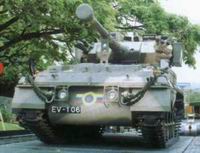 |
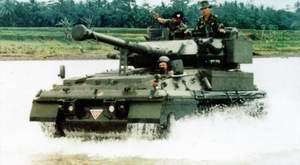 |
 |
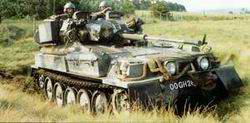 |
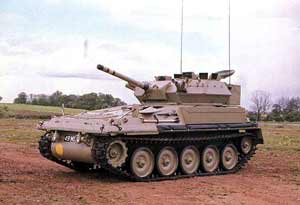 |
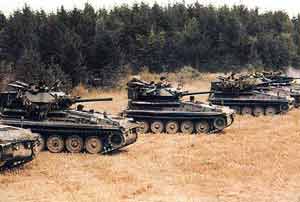 |
 |
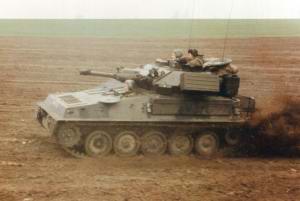 |
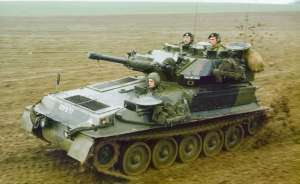 |
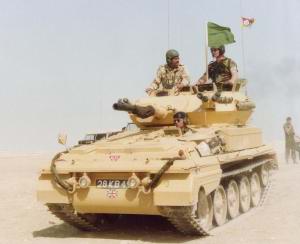 |
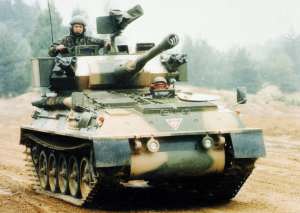 |
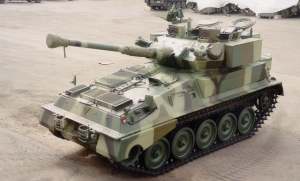 |





















